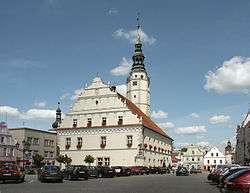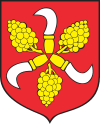Głogówek
| Głogówek Oberglogau | |||
|---|---|---|---|
|
Town Hall on Main Square | |||
| |||
 Głogówek Oberglogau | |||
| Coordinates: 50°20′38″N 17°52′2″E / 50.34389°N 17.86722°E | |||
| Country |
| ||
| Voivodeship | Opole | ||
| County | Prudnik | ||
| Gmina | Głogówek | ||
| Established | 11th century | ||
| Town rights | 1275 | ||
| Government | |||
| • Mayor | Andrzej Jan Kałamarz | ||
| Area | |||
| • Total | 22.06 km2 (8.52 sq mi) | ||
| Elevation | 212 m (696 ft) | ||
| Population (2006) | |||
| • Total | 5,816 | ||
| • Density | 260/km2 (680/sq mi) | ||
| Time zone | CET (UTC+1) | ||
| • Summer (DST) | CEST (UTC+2) | ||
| Postal code | 48-250 | ||
| Area code(s) | +48 77 | ||
| Car plates | OPR | ||
| Website | http://www.glogowek.pl | ||
Głogówek [ɡwɔˈɡuvɛk], German Oberglogau (earlier Klein Glogau or Kraut Glogau, Czech: Horní Hlohov) is a city in Poland located in Opole Voivodeship in Upper Silesia. The city lies approximately 35 kilometres (22 miles) from Opole, the capital of the voivodeship, and is about 10 km (6 mi) from the Czech border. The name of the city comes from the Polish word głóg, meaning hawthorn. The plant grew quite thickly in the area when the city was founded.
Since 2009 the town has been bilingual in German and Polish, a substantial German population having remained in the area after Silesia was ceded to Poland and the end of World War II.
History
It is often said that the first historical mention of Głogówek was in 1076, but this is now known to be false. The Russian sources frequently quoted citing the city's 11th century founding were misinterpreted, referring instead to a Lower Silesian town, Głogów, with a very similar name. This village, first mentioned in 1010, was located some distance from Głogówek and later became a fortified castle by the Oder and a major city. However, given the ages of the Russian texts, a mistake in identifying the first historical mentions of the two villages is understandable. At the time, military conflict in the region was common, and the use of the Głogów fortress may very well have inspired the names of smaller villages in the surrounding area, causing the confusion.
The first unequivocal historical mention of Głogówek in a Silesian source dates from 1212. This source is a list of villages which were in the tithing area of the Leubus Cloister. The village was referred to as "Glogov" in the Latin text, which describes, in some detail, the boundaries of the village. This description could only apply to the present-day village, and is considered to be the first unambiguous mention of Głogówek. Town privileges were granted to Głogówek in 1275. Another error in Silesian record-keeping states that Głogówek, still a fairly small town, had 12 official representatives, a number much too large for a city of that size. Wrocław, a much larger city, had only five at the time. The city was later granted German town privileges as well.
In 1327, Oberglogau, like all other Silesian villages, came under Bohemian rule. The town's city rights were renewed again in 1373, this time under the Magdeburg rights provision. In 1379, a church, Saint Bartholomew's, was built. Only a few years later, the duke of Opole, Ladislaus II (+1401), built another large cloister in Mochau Pauliner-Wiese, associated with Częstochowa in the area. In 1643, the village was largely destroyed by Swedish invaders. The Polish king John II Casimir Vasa sought refuge during the invasion by staying in a castle in the village from October 17, 1655 until December 18 of the same year. After the First Silesian War in the 18th century Oberglogau and many other villages in the area came under Prussian control. The village was for the most part destroyed in a large fire in 1765. In addition, Ludwig van Beethoven came to stay in the city's castle, using it to finish his fourth symphony. The city was connected to the railroad network in 1876 when its population, which was almost completely bilingual, stood at 6,000, and by 1880 the population had decreased to 5,000. The population stood at 7,500 at the outbreak of World War II, which destroyed 40% of the city.
During the Second World War the town, then known as Oberglogau, was the base for a working party (E600) of British and Commonwealth prisoners of war, under the administration of Stalag VIIIB/344 at Lamsdorf (currently Łambinowice). The prisoners were working in a sugar beet factory (Hotzenplotzer Zucher Fabrik). In January 1945, as the Soviet armies resumed their offensive and advanced from the east, the prisoners were marched westward in the so-called Long March or Death March. Many of them died from the bitter cold and exhaustion. The lucky ones got far enough to the west to be liberated by the allied armies after some four months of travelling on foot in appalling conditions.[1]
International relations
Twin towns — Sister cities
Głogówek is twinned with: Rietberg, (Germany), Vrbno pod Pradědem, (Czech Republic)
Gmina
Głogówek is the seat of a Gmina, a Polish administrative division similar to a parish. The Gmina has an area of 170.06 square kilometres (65.66 sq mi), and contains the villages of Biedrzychowice, Błażejowice Dolne, Cieszniów, Dzierżysławice, Góreczno, Kazimierz, Kazimierz-Anachów, Kierpień, Leśnik, Mionów, Mochów, Nowe Kotkowice, Nowe Kotkowice-Chudoba, Racławice Śląskie, Rzepcze, Stare Kotkowice, Szonów, Tomice, Twardawa, Twardawa-Małkowice, Wierzch, Wróblin, Zawada, Zawada-Bud, Zawada-Golczowice, Zawada-Mucków, Zawada-Sysłów und Zwiastowice. The population of the Gmina is 14,265.
Famous residents
Natives
- House of the Von Oppersdorf(f),[2] a Silesian nobile house
- Franz Graf von Oppersdorff (1778 – 1818), a great lover of music, patron of Beethoven
- Eduard Maria Graf von Oppersdorff, Freiherr von Aich und Friedstein (1800 – 1889, here)[3]
- Hans Georg Graf von Oppersdorff (1866 – 1948, Lourdes)[4]
- Johann (Giovanni) Stanetti (1663 – 1726, Vienna), Austrian sculptor
- Johann Sedlatzek (1789 – 1866, Vienna), Austrian flutist
- Wilhelm Fraenkel (1844 – 1916, Vienna), Austrian Jewish architect and master public survant for urban development (German: Stadtbaumeister) of Vienna[5]
- Karl Zuschneid (1856 – 1926, Weimar), German musicologist and director of the Mannheim Academy of Music
- Gerhard Strecke (1880 – 1968, Ratingen), German composer/actor
- Albert Willimsky (1890 - 1940, Sachsenhausen concentration camp), German Catholic priest, anti-Nazi activist, and martyr
- Hildegard von der Gablentz (1901 - 1961), German politician
- Walter Ofiera, (1911 - 1995), German Actor
- Joachim Georg Görlach (1931 - 2009), German composer, conductor, and journalist
- Siegfried Tann (b. 1942), German politician of the CDU[6]
- Peter Peschel (b. 1972), German footballer
Other residents
- Ludwig van Beethoven (1770 - 1827), German composer and pianist
- The grandfather of American actress Uma Thurman, Friedrich Karl Johannes von Schlebrügge, was born on 21 November 1886 in Oberglogau and emigrated in the 1930s to Sweden.
- The great-grandmother of the United States' Democratic Party's 2004 presidential candidate John Kerry, Mathilde Fränkel, was born on 14 August 1845 in Oberglogau.
References
External links
| Wikimedia Commons has media related to Głogówek. |
- (Polish), (German) Official website of the city
- (Polish) Głogówek Online Information Portal of Głogówek Community
- Jewish Community in Głogówek on Virtual Shtetl
Coordinates: 50°22′N 17°52′E / 50.367°N 17.867°E


